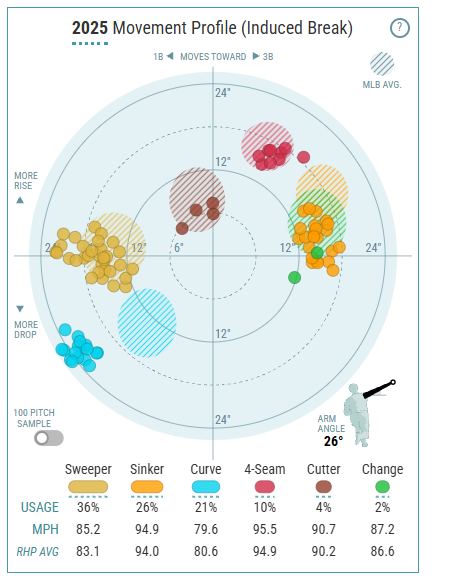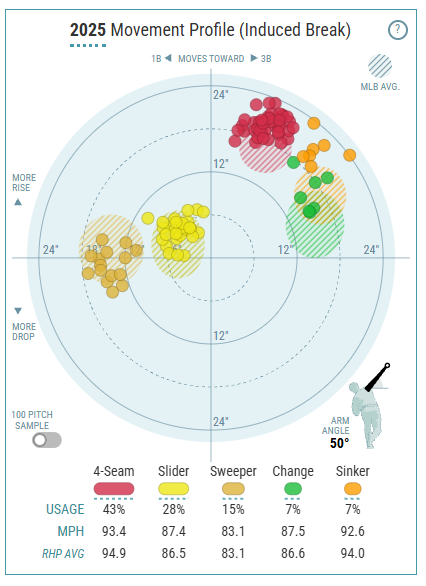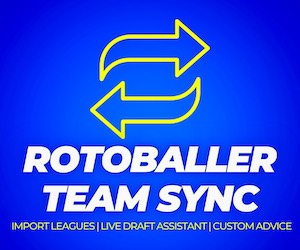Elliott looks at pitchers with surprising starts recently. These SPs could emerge as fantasy baseball waiver wire targets for Week 21 in 2025, or just mirages.
Welcome back to the "Are You For Real?" series as we dive into Week 21 of the 2025 fantasy baseball season. For those unfamiliar, this is a weekly column where we examine starting pitchers who had surprisingly strong starts over the past week and put them under the microscope to determine whether they're legitimate or just smoke and mirrors.
It was all about the rookies this week, as we've got three exciting rookies to break down. First, we'll deep dive Hurston Waldrep's strong start against the Guardians on Friday. Then, we'll look at Nolan McLean's dominant debut on Saturday. We'll finish it off by putting Kansas City's Ryan Bergert under the microscope following a good start against the White Sox.
Roster percentages are taken from Yahoo! and are accurate as of August 18.
Be sure to check all of our fantasy baseball lineup tools and resources:- Fantasy baseball trade analyzer
- BvP matchups data (Batter vs. Pitcher)
- PvB matchups data (Pitcher vs. Batter)
- Who should I start? Fantasy baseball comparisons
- Daily MLB starting lineups
- Fantasy baseball closer depth charts
- Fantasy Baseball live scoreboard
- Fantasy baseball injury reports
Hurston Waldrep, Atlanta Braves – 44% Rostered
2025 Stats (prior to this start): 11.2 IP, 1.54 ERA, 2.17 FIP, 15.9% K-BB%
08/15 @ CLE: 6 IP, 2 H, 0 ER, 2 BB, 7 K
Waldrep was outstanding on Friday, blanking the Guardians for six scoreless innings en route to his third consecutive victory. Waldrep has been a revelation to Atlanta’s depleted rotation since being promoted earlier this month. Can Waldrep be a difference maker down the stretch?
Originally a first-round pick by Atlanta back in 2023, Waldrep was one of Atlanta’s top prospects coming into the season. Scouts viewed him as a future starter with big strikeout upside thanks to his nasty splitter. Waldrep works with a six-pitch mix consisting of a splitter, cutter, sinker, curveball, slider, and four seam fastball.
Waldrep may have six pitches, but there is one that clearly stands out, and that is the splitter. Waldrep’s splitter is what made him a prospect to begin with, as he was racking up strikeouts in the minor leagues with this pitch. An 86.9 mph offering. Waldrep’s splitter is notable for some extreme measurables. He has plus vertical and horizontal movement with the pitch, and has averaged an incredible 711 RPM with his splitter as well.
A low spin rate is ideal for a split-change like this, and 711 is remarkably low. For context, only three qualified pitchers have a splitter spin rate below 800 RPM this season, and two of them are relievers. A low spin rate helps increase the pitch’s drop and therefore deceptiveness. That’s how Waldrep gets all those nasty swings and misses with the pitch. Here’s an example of Waldrep’s splitter.
— Elliott Baas (@ElliottBaasBB) August 18, 2025
That’s filthy stuff, and Waldrep has gotten some nutty numbers with his splitter so far. Opponents are hitting just .048 against the pitch with a .042 wOBA. He has allowed a 92.1 mph average exit velocity with the pitch, however this is such a small sample size it’s hard to determine whether hard contact will be an ongoing issue for Waldrep.
He won’t be able to maintain his .048 AVG against, but one encouraging stat is his 54.3% whiff rate with his splitter. That is a dominant whiff rate for any pitch, and it suggests that Waldrep has big strikeout upside. He racked up eight of his 14 whiffs with his splitter in this start. The splitter was touted as the gem of Waldrep’s arsenal, and the pitch looks as advertised so far. Waldrep could anchor his game around this pitch and find success.
Waldrep’s next most used pitch has been the cutter, which he’s thrown 18.2% of the time overall and 23% of the time in this start. A 93.2 mph offering, Waldrep’s cutter isn’t quite as hard as his sinker or four seamer. It has displayed average movement for a cutter, and had a traditional shape. Opponents have struggled against the pitch so far, with a .214 AVG, .286 SLG, and a .275 wOBA against.
Waldrep has thrown the pitch more often to left-handed batters and more often when behind in the count. It’s not a strikeout pitch like his splitter either, with just an 8.7% whiff rate so far. That is to be expected with this movement profile, and Waldrep’s cutter will serve him more as a groundball pitch than a strikeout pitch. He has a 3-degree average launch angle against and a 57.1% groundball rate thus far. This cutter isn’t as sexy as the splitter, but it could be an effective offering too.
Waldrep’s next most used pitch in this start was the slider, which he threw 22% of the time. Waldrep hadn’t used his slider too often in his first two starts, but really ramped up his usage against Cleveland. An 87.8 mph offering, Waldrep has slightly above average vertical movement and slightly below average horizontal movement with his slider, giving it an atypical shape that could serve as a deceptive pitch. While it doesn’t measure up as well as his splitter, Waldrep did earn five of his 14 whiffs with the slider on Friday. This is an excellent complement to the splitter, and could serve as a strong strikeout offering in its own right.
Waldrep has plenty of secondary stuff, but what about the fastball? He uses both a sinker and a four seamer, throwing the sinker 15.6% of the time and the four seamer 9.3% of the time. He used his four-seamer slightly more than the sinker in the start against Cleveland, but we’re talking about 7% vs. 9%. Waldrep has decent velocity, averaging 95.7 mph with his sinker. Waldrep has also displayed below average movement and average spin with his fastballs.
Fastballs are not what made Waldrep a prospect, and he has mostly used his fastballs either when behind in the count or as a first pitch. For Waldrep, it’s all about setting up the secondary stuff, and he can use these fastballs to do so, but they aren’t standout offerings on their own.
One area of concern I have with Waldrep that hasn’t come to fruition yet is control issues. Waldrep consistently displayed poor control throughout his minor league career, with walk rates that were routinely above 10%. He’s only issued five walks in 17.2 innings so far, which is more than manageable, but I’m not sure I trust this walk rate to hold. Waldrep’s 52% zone rate is higher than his minor league zone rates, but again we haven’t seen enough to trust that he can maintain this. Really, we haven’t seen enough to trust anything with Waldrep yet, but there are enough positive signs here to have me intrigued.
Verdict:
Scouts raved about Waldrep’s splitter, and that pitch looks as advertised so far in the major leagues. It’s been lights out for opponents when Waldrep throws his splitter, with a monster 54.3% whiff rate in three appearances. With incredibly low spin and movement that deviates from average, Waldrep’s splitter seems to have what it takes to be a strikeout pitch in the major leagues. The splitter is the gem of his arsenal, but Waldrep has plenty of pitches at his disposal as well.
He has a solid cutter that’s done a good job at generating groundballs, and his slider has complemented his splitter nicely as a alternative strikeout offering. Waldrep also has plus velocity with his four seamer and sinker, though has just average movement and spin. The fastballs can work to set up his stronger secondary stuff, and that’s been their primary purpose thus far. Waldrep may struggle with walks at times, but this is a must add pitcher in 12 team leagues or deeper. With a six pitch deep arsenal led by an extraordinary splitter, Waldrep is too enticing to leave on waivers.
Nolan McLean, New York Mets – 27% Rostered
2025 Stats (Minors): 113.2 IP, 2.45 ERA, 3.65 FIP, 16.5% K-BB%
08/16 vs. SEA: 5.1 IP, 2 H, 0 ER, 4 BB, 8 K
McLean was fantastic in his big league debut on Saturday, fanning eight Mariners while picking up his first career victory in the process. McLean was one of the Mets top prospects coming into the season, and with a bevy of injuries and underwhelming performances in the rotation the Mets felt like they needed a spark. Could McLean be the spark both the Mets and our fantasy teams are looking for?
Originally a third-round pick by the Mets back in 2023, McLean was actually a two-way player in the minor leagues, but struggled mightily at the plate with strikeout rates near 50%. Pitching seemed to be his calling, as he’s diced up the competition with 27.2% K rate this season and has a deep arsenal. McLean works with a six-pitch mix consisting of a sweeper, sinker, curveball, four seam fastball, changeup, and cutter.
McLean may have a deep arsenal, but he featured a few of his pitches more prominently on Saturday, including his sweeper, which he threw 36.3% of the time. An 85.2 mph offering, McLean’s sweeper is noteworthy for its extreme spin and plus horizontal break. McLean averaged a whopping 2995 RPM with his sweeper in this start, which would have him near the top of the league in terms of sweeper spin rate. Here is an example from this start.
— Elliott Baas (@ElliottBaasBB) August 18, 2025
Looks like a classic sweeper there, with big glove side movement making it difficult for batters to read. McLean confounded hitters with this pitch, earning four of his 11 whiffs with the sweeper. Between the extreme spin, plus movement, and above average velocity, McLean’s sweeper has all the ingredients of a dominant strikeout pitch. It might be tough for him to replicate his 27.2% minor league strikeout rate, especially right away, but he could be a plus strikeout pitcher.
McLean’s next most used pitch was the sinker, which he threw 26% of the time. A 94.9 mph offering, McLean has plus velocity and average spin with his sinker, which seems to be his primary fastball. He did display 28 inches of vertical break with the pitch in this start, which is solidly above league average.
I’m hopeful this can be a good groundball pitch for McLean. He routinely had strong groundball rates around or above 50% in the minor leagues, and it would be nice to see that skill translate to the majors. Pitchers with nasty breaking balls are already exciting, but a pitcher with nasty breaking balls who can also induce grounders can really take off.
McLean’s third most used pitch was the curveball, which he threw 21% of the time. It was mostly about the sweeper, sinker, and curveball for McLean in this start as he threw each pitch more than 20% of the time, but didn’t throw any other pitch more than 10% of the time.
Much like the sweeper, the curveball is elite in terms of spin rate. McLean averaged 79.6 mph on the gun with his curveball, but he averaged 3279 RPM as well. No qualified pitcher has a higher average curveball spin rate this season. The curveball also has some wild movement, with nearly six inches of drop above average and more than seven inches of break above average. Have a look at McLean’s pitch movement profile from this game (curveball in blue).
That is some curveball shape, and boy did the Mariners have trouble with this pitch. McLean racked up five of his 11 whiffs with the curveball and allowed a 30-degree average launch angle when batters did manage to make contact. Here’s an example from this start.
— Elliott Baas (@ElliottBaasBB) August 18, 2025
It truly is a thing of beauty, and this pitch gives McLean a second strikeout offering along with the sweeper. He maintained high strikeout rates in the minor leagues, and that may be able to translate to the majors.
McLean did throw nine four seamers at 95.5 mph. While the velocity is decent, McLean does not have the elite spin or movement with his four-seamer. It’s rather flat and will probably be the second option compared to his sinker. The sinker, while not as hard, has better movement and could serve as a primary fastball.
One issue with McLean could be his poor control. His walk rates usually fell between 9%-11% in the minor leagues, and he issued four walks on Saturday. It’s sort of the classic problem for a hotshot up-and-coming prospect like McLean, but I fear he could unravel. He got away with the four walks this time because the Mariners were swinging through everything, but he may not be so lucky going forward. It also led to some inefficiency on the mound, as it took him 91 pitches to get 16 outs. This isn’t enough to scare me off McLean, but control could be a struggle for him as he finds his footing in the major leagues.
Another potential issue for McLean could be an innings or workload limit. He’s already thrown 119 innings this season after throwing 109.2 innings last year, so it’s possible that the Mets have a cap on his innings or could limit him to shorter starts. The Mets are fighting for a playoff spot so they may just use him anyway, but it’s a possibility. Again, I don’t think this is enough to scare me off McLean, but fantasy managers should know that this is a possibility.
Verdict:
McLean is a must-add player in 12-team leagues or deeper at this juncture in the season. He wields a pair of plus breaking balls effectively and should be an above average strikeout pitcher. He uses a 95 mph sinker as his primary breaking ball and could be a good groundball pitcher thanks to this pitch. The stuff itself is very enticing, with McLean turning hitters around on Saturday with his nasty curveball and sweeper. His biggest issues on the mound could be control and inefficiency. McLean issued his fair share of walks in the minor leagues and handed out four free passes on Saturday. He also may not go deep enough to earn a win or quality start often, so he’s mostly going to help with ratios and strikeouts. Still, he is worth picking up in all but the shallowest of leagues.
Ryan Bergert, Kansas City Royals – 26% Rostered
2025 Stats (prior to this start): 47 IP, 2.87 ERA, 4.03 FIP, 12% K-BB%
08/17 vs. CHW: 5.1 IP, 6 H, 2 R (1 ER), 2 BB, 7 K
Bergert continued to pitch well in his new home, fanning seven over five and one-third innings in the no decision. Pitching as a swingman for the Padres prior to a deadline deal that sent him to Kansas City, Bergert has quietly been quite effective on the hill. He has a 2.98 ERA as a starter this season, and has pitched into the sixth inning in each of his first three starts with the Royals. Perhaps Kansas City is stretching him out or has bigger plans for Bergert? And more importantly, perhaps he could have value for our fantasy teams?
Originally a sixth-round pick by the Padres back in 2021, Bergert wasn’t much of a prospect coming up, especially in comparison to the other two pitchers I’ve covered in this article. He doesn’t necessarily have the big velocity or extreme spin with his pitches that those other guys have. Bergert works with a five-pitch mix consisting of a four-seam fastball, slider, sweeper, changeup, and sinker.
Bergert’s most used pitch this season has been the four-seam fastball, and that was no different on Sunday as he threw his fastball 41% of the time versus the White Sox. A 93.4 mph offering, Bergert is below average in velocity and above average in spin at 2401 RPM. Opponents have really struggled against Bergert’s fastball, hitting just .173 with a .280 SLG and a .277 wOBA. The expected stats are a little less favorable, but still strong with a .225 xBA, .407 xSLG, and .339 xwOBA.
Why is a 93 mph fastball getting these results? Shape. Bergert has some extreme movement on his four-seam fastball, including 18.7 inches of induced vertical break. Higher induced vertical break improves a fastball’s “rise”, meaning the ball does not drop as much as the hitter anticipates and they either swing and miss or misjudge the location and make poor quality contact. This is what players mean when they say a fastball rises. A thrown pitch doesn’t literally rise as that would be physically impossible; rather, the ball doesn’t follow a normal trajectory due to spin. Let’s have a look at Bergert’s movement profile (four-seamer in red).
As you can see, the pitch deviates upward from an average four-seam fastball. Bergert even has a solid 16.9% whiff rate with his four-seamer, and has done an excellent job at inducing flyballs with the pitch. He has a 55.6% flyball rate with his four-seamer this season. Flyballs are the least likely batted ball type to land for a hit, so a flyball-heavy approach can be fruitful for a pitcher, especially pitching in Kansas City.
One thing that worries me is the amount of hard contact Bergert is surrendering with the pitch. He has a 93.4 mph average exit velocity against his four-seamer this season. That amount of hard contact paired with a high flyball rate can be trouble, though Bergert hasn’t struggled with home runs much throughout his professional career other than his time in the notoriously hitter-friendly PCL this season. The hard contact is scary, but I don’t think this will sink Bergert.
Bergert’s next most used pitch has been the slider, which he throws 27.6% of the time. An 87.6 mph offering, Bergert’s slider has good spin at 2621 RPM, though it has around league average movement. Here’s an example from this season.
— Elliott Baas (@ElliottBaasBB) August 18, 2025
Looks good there, and Bergert has gotten some outstanding results with this pitch so far. Batters are hitting just .172 against the slider with a .297 SLG and a .235 wOBA. The expected stats suggest that some regression is coming with a .224 xBA, .405 xSLG, and a .297 xwOBA. Bergert has an impressive 33.3% whiff rate with his slider this season, and piled up eight of his 15 whiffs with the pitch on Sunday. This slider isn’t exceptional like Waldrep’s splitter or McLean’s breaking balls, but it is a solid pitch that should allow Bergert to maintain at least a league average strikeout rate.
His next most used pitch is the sweeper, which he’s thrown 15.3% of the time. An 83.1 mph offering, Bergert’s sweeper is a softer pitch with more movement compared to his slider. Here is an example from earlier this season.
— Elliott Baas (@ElliottBaasBB) August 18, 2025
It’s loopier and has more vertical and horizontal movement versus the slider, and hitters have struggled against this pitch as well, batting just .167 with a .458 SLG and a .277 wOBA. The expected stats are a little less rosy with a .252 xBA, .519 xSLG, and a .338 xwOBA. Bergert only has a 22.4% whiff rate with this pitch and has given up a 21-degree average launch angle against as well. It’s not as good a pitch as his slider, but this is a solid third offering to solidify his repertoire.
Bergert also throws a changeup and a sinker about 7% of the time each. The changeup has been crushed for a .385 AVG, .538 SLG, and .418 wOBA. This could be small sample size flukiness as Bergert has a 50% line drive rate against with his changeup this season. A .294 xBA and .359 xSLG suggest that he could experience regression with this pitch, and he does have an intriguing 37% whiff rate with it so far. The sinker is a 92.6 mph offering that Bergert has thrown almost exclusively to right-handed hitters. He seems to go to the sinker in place of the four-seamer on occasion, but I don’t anticipate this becoming a big part of Bergert’s game going forward.
There is one other issue with Bergert that should be addressed, and that is luck. He has been on the receiving end of some great fortune so far this season, and I’m not sure that will continue to hold. There are three stats I like to look at to get a baseline evaluation of a pitcher’s luck, and those are BABIP, LOB rate, and HB/FB rate. Bergert is overperforming in all three metrics. He has a .224 BABIP (league .289) against so far, an 83.3% LOB rate (league 72.4%), and a 9% HR/FB ratio (league 11.6%).
As I previously mentioned, Bergert does a good job of inducing flyballs which influences these metrics to a degree. He may be able to sustain an above average BABIP and HR/FB ratio, but 52.1 innings is hardly enough of a sample to make such a determination. Even if he can influence these to a degree, the BABIP and LOB rates will both surely rise over time and pump up Bergert’s ratios. He’s also struggled with walks at times and has a 10.7% walk rate this season, raising his WHIP and suggesting that more batters should be coming around to score. Bergert has some talent, but he’s not a 2.75 ERA pitcher. His 4.03 FIP and 4.38 SIERA are likely closer to where his ERA will land.
Verdict:
Bergert isn’t a big name prospect like Waldrep or McLean, but that doesn't mean there’s no fantasy value here. He has gotten some excellent results with his three primary pitches so far, the four-seamer, slider, and sweeper. The four-seamer has displayed strong induced vertical break and could be great at tying hitters up near the top of the zone, or just at inducing pop ups and flyballs. The slider has average movement, but plus spin and has put up some good whiff numbers so far, making it Bergert’s best strikeout pitch. His sweeper isn’t as effective in terms of strikeouts, but is a solid third offering that he can use against both lefties and righties.
Bergert has a nice repertoire, but he’s undoubtedly overperformed this season. He’s not a 2.75 ERA pitcher, and his ERA could rise a full run or more if and when regression hits. His .224 BABIP, 83.3% LOB rate, and 9% HR/FB rate are all indicators of good fortune in Bergert’s favor. I do think he’s worth an add in most fantasy leagues if you’ve missed out on one of the big names. He’s not a league winner, but he could be a solid arm down the stretch.
More Fantasy Baseball Advice
Download Our Free News & Alerts Mobile App
Like what you see? Download our updated fantasy baseball app for iPhone and Android with 24x7 player news, injury alerts, sleepers, prospects & more. All free!






 RADIO
RADIO


























